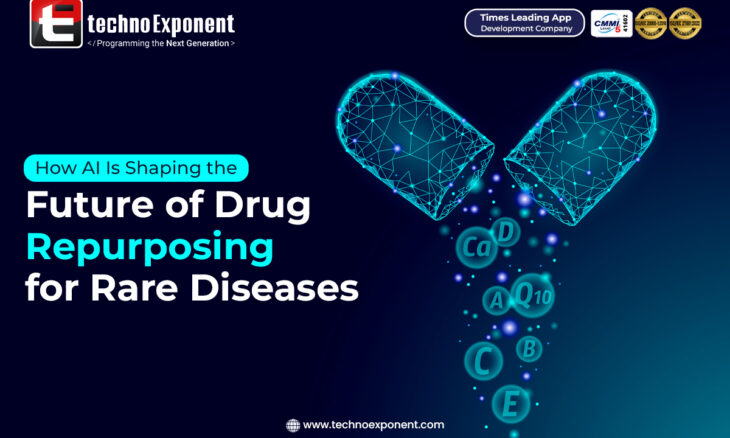
Millions worldwide suffer from rare diseases, yet most lack effective treatments due to slow and costly drug development. AI is changing that. TxGNN, an advanced AI tool from Harvard Medical School, has identified drug candidates for over 17,000 diseases, offering new hope for patients with limited or no options. Unlike traditional methods, it accurately predicts treatments and side effects. “This is precisely where we see the promise of AI in reducing the global disease burden,” says lead researcher Marinka Zitnik. In this blog, we’ll discuss how AI is revolutionizing drug discovery and transforming the fight against rare diseases.
The Importance Of Drug Repurposing
Drug repurposing is changing the way we find treatments, making the process faster, more affordable, and more accessible. Developing a new drug from scratch takes years and costs billions, leaving many rare diseases without solutions. But repurposing existing medicines—ones already tested for safety—can speed things up significantly. This is especially important for conditions that don’t get much research funding or attention. By giving existing drugs a second purpose, researchers can bring hope to patients who have waited too long for answers.
AI is making this process even smarter. Instead of relying on trial and error, AI tools like TxGNN can analyze massive amounts of medical data to find unexpected connections between diseases and existing medicines. This means more precise matches, fewer wasted resources, and a better chance of finding effective treatments quickly. For patients with rare or neglected conditions, AI-powered drug repurposing could mean the difference between living with an untreatable illness and finally getting the help they need.
How the New AI Tool Redefines Drug Discovery
Most AI models for drug discovery tend to focus on just one disease or a small group of conditions, which can limit their usefulness. The new AI tool, however, takes a broader approach. It identifies common patterns and features, like shared genetic changes, across many different diseases. This allows it to make predictions not just for diseases with known treatments, but also for conditions that have no effective therapies. “We’ve tended to rely on luck and serendipity rather than on strategy, which limits drug discovery to diseases for which drugs already exist,” said Zitnik. In essence, it mirrors the way a human doctor might use their experience and knowledge to come up with new treatment ideas, even when faced with limited information.
What makes this tool stand out is the vast amount of data it can process. It’s trained on everything from DNA and gene activity to clinical notes and cell signals, giving it a deep understanding of how diseases work. The researchers put it to the test by asking it to identify drug candidates for various diseases, even rare ones. The model also predicted which drugs might not be safe for certain patients, offering valuable insights.
In one test, the AI was challenged with three rare diseases it hadn’t seen before. Not only did it recommend treatments, but it also provided clear, logical explanations that matched existing medical knowledge. “With this tool, we aim to identify new therapies across the disease spectrum,” said Zitnik. This transparency boosts the confidence doctors have in using the tool. While the model’s predictions will still need more testing, it’s clear that this AI tool is changing the game when it comes to repurposing drugs and discovering new treatments—especially for rare diseases.
Solutions Found Through AI in Drug Repurposing for Rare Diseases
AI is not only transforming drug repurposing but also offering practical solutions that were previously unimaginable. The innovative use of AI tools like TxGNN has already led to breakthroughs in identifying drug candidates for rare diseases, many of which have long been neglected by traditional research methods. Through its ability to process vast amounts of data, including genomic, clinical, and molecular information, the AI model has discovered potential therapies for over 17,000 diseases. This is a significant leap forward in the search for treatments, providing researchers with new options for conditions that have been overlooked by the pharmaceutical industry.
Another key solution is AI’s ability to predict not only which drugs might work for a given disease but also their potential side effects and contraindications. This level of insight can dramatically reduce the risks associated with drug trials. By analyzing diverse patient data, AI tools can predict which patients will benefit most from a particular drug, ensuring that repurposed treatments are both safe and effective.
AI also helps to overcome the limitations of small sample sizes typically associated with rare diseases. With its ability to analyze vast amounts of data from various sources, AI can generate insights that would have been impossible to obtain through conventional research methods. This opens up new possibilities for finding treatments, offering hope to patients who have waited for years for a breakthrough.
As Zitnik emphasized, ‘The promise of this approach is to bridge the gap in healthcare, offering new hope for those affected by diseases that have long been neglected.’”
 +44 141 628 8980
+44 141 628 8980
 (786) 269-2247
(786) 269-2247
 +61 872007153
+61 872007153
 +91 8900027268 (Sales only)
+91 8900027268 (Sales only)








